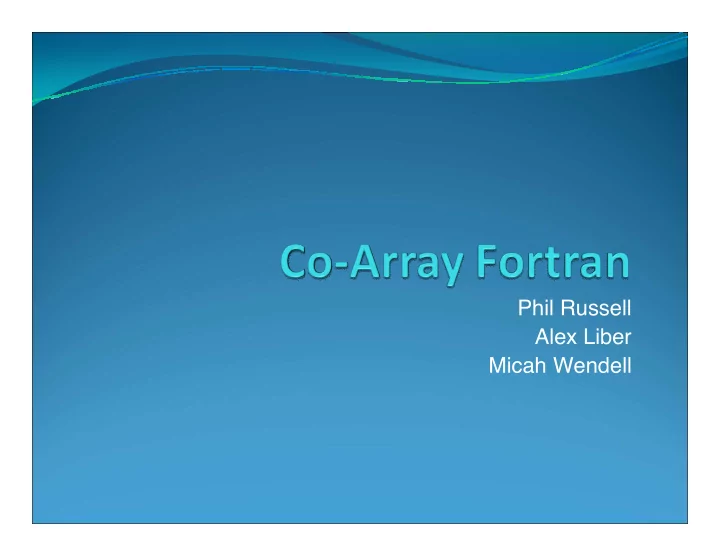

Phil Russell Alex Liber Micah Wendell
What It Is � Formally called F--, � Small set of semantic extensions to Fortran 95 � Simple syntactic extension to Fortran 95 � Single Program Multiple Data, SPMD, parallel processing
What It Is � Robust, efficient parallel language. � Requires learning only a few new rules. � Rules handle two fundamental issues: Work distribution Data distribution.
Work Distribution � A single program is replicated a fixed number of times � Each replication has its own set of data objects. � Each replication of the program is called an image. � Each image executes asynchronously
Work Distribution � The normal rules of Fortran apply � The execution path may differ from image to image. � The programmer determines the actual path for the image with A unique image index Normal Fortran control constructs Explicit synchronizations.
Work Distribution � Code between synchronizations The compiler is free to use all its normal optimization techniques, as if only one image is present
Data Distribution � Specify the data relationships � One new object, the co-array, is added to the language � An example…
Data Distribution REAL, DIMENSION(N)[*] :: X,Y X(:) = Y(:)[Q] The above statement declares that each image has two real arrays of size N. If Q has the same value on each image, the effect of the assignment statement is that each image copies the array Y from image Q and makes a local copy in array X.
Data Distribution � (index) follow the normal Fortran rules within one memory image. � [index] provide access to objects across images and follow similar rules. � [bounds] in co-array declarations follow the rules of assumed-size arrays since co-arrays are always spread over all the images.
Data Distribution � The programmer uses co-array syntax only where it is needed � A co-array reference with no square brackets is a reference to the object in the local memory � Co-array syntax should appear only in isolated parts of the code � If not, too much communication among images? Flags compiler to avoid latency Flags programmer to rethink
Extended Fortran 90 Array Syntax � A way of expressing remote memory operations. Here are some simple examples: � X = Y[PE] get from Y[PE] � Y[PE] = X put into Y[PE] � Y[:] = X broadcast X � Y[LIST] = X broadcast X over subset of PE's in array LIST � Z(:) = Y[:] collect all Y � S = MINVAL(Y[:]) min (reduce) all Y � B(1:M)[1:N] = S S scalar, promoted to array of shape (1:M,1:N)
Input/Output � Input/output problem with SPMD programming models � Fortran I/O assumes dedicated single-process access to an open file Often violated when it is assumed that I/O from each image is completely independent.
Input/Output � Co-Array Fortran includes only minor extensions to Fortran 95 I/O, � All the inconsistencies of earlier programming models have been avoided � There is explicit support for parallel I/O. � I/O is compatible with both process-based and thread-based implementations.
Other Fortran 95 additions: Several Intrinsics � NUM_IMAGES() returns the number of images, � THIS_IMAGE() returns this image's index between 1 and NUM_IMAGES() � SYNC_ALL() is a global barrier � To only wait for the relevant images to arrive. SYNC_ALL(WAIT=LIST)
More Intrinsics � SYNC_TEAM(TEAM=TEAM) � SYNC_TEAM(TEAM=TEAM,WAIT=LIST) � START_CRITICAL and END_CRITICAL
Adding Synch Functionality � SYNC_MEMORY(). This routine forces the local image to both complete any outstanding co-array writes into ``global'' memory and refresh from global memory any local copies of co- array data it might be holding (in registers for example). Image synchronization implies co-array synchronization. � A call to SYNC_MEMORY() is rarely required Implicitly called before and after virtually all procedure calls including Co-Array's built in image synchronization intrinsics.
Image and co-array synchronization Example: exchanging an array with your north and south neighbors: COMMON/XCTILB4/ B(N,4)[*] SAVE /XCTILB4/ CALL SYNC_ALL( WAIT=(/IMG_S,IMG_N/) ) B(:,3) = B(:,1)[IMG_S] B(:,4) = B(:,2)[IMG_N] CALL SYNC_ALL( WAIT=(/IMG_S,IMG_N/) )
Array Exchange Synchronization Explained � The first SYNC_ALL waits until the remote B(:,1:2) is ready to be copied � The second waits until it is safe to overwrite the local B(:,1:2). � Only nearest neighbors are involved in the sync. � It is always safe to replace SYNC_ALL(WAIT=LIST) calls with global SYNC_ALL() calls Often is significantly slower. Either the preceding or succeeding synchronization may be avoidable.
Synch Optimization � The majority of remote co-array access optimization is minimizing the synchronization Frequency of synchronization Cover the minimum number of images � On machines without global memory hardware, array syntax (rather than DO loops) should always be used for remote memory operations � Copying co-array's into local temporary buffers before they are required might be appropriate
Data Parallel Cumulative Sum In data parallel programs, each image is either performing the same operation or is idle. For example here is a data parallel fixed order cumulative sum: REAL SUM[*] CALL SYNC_ALL( WAIT=1 ) DO IMG= 2,NUM_IMAGES() IF (IMG==THIS_IMAGE()) THEN SUM = SUM + SUM[IMG-1] ENDIF CALL SYNC_ALL( WAIT=IMG ) ENDDO
Data Parallel Performance Critique � SYNC_ALL waiting on just the active image improves performance � still NUM_IMAGES() global sync
An Alternative to Data Parallel A better alternative may be to minimize synchronization by avoiding the data parallel overhead entirely: REAL SUM[*] ME = THIS_IMAGE() IF (ME.GT.1) THEN CALL SYNC_TEAM( TEAM=(/ME-1,ME/) ) SUM = SUM + SUM[ME-1] ENDIF IF (ME.LT.NUM_IMAGES()) THEN CALL SYNC_TEAM( TEAM=(/ME,ME+1/) ) ENDIF
Alternative Performance Analysis � Now each image is involved in at most two sync's: the images just before and just after it in image order. � The first SYNC_TEAM call on one image is matched by the second SYNC_TEAM call on the previous image.
Benefits (or: In Summary) � The Co-Array Fortran synchronization intrinsics can : Improve the performance of data parallel algorithms Provide implicit program execution control as an alternative to the data parallel approach.
Amusement
Recommend
More recommend